K. N. Amarawardhana, N. S. Senanayake, Ruchira Abeyweera
Faculty of Engineering Technology, The Open University of Sri Lanka, Nawala, Nugegoda, Sri Lanka
Correspondence to: N. S. Senanayake, Faculty of Engineering Technology, The Open University of Sri Lanka, Nawala, Nugegoda, Sri Lanka.
| Email: |  |
Copyright © 2015 Scientific & Academic Publishing. All Rights Reserved.
Abstract
Tourism industry in Sri Lanka shares a substantial amount of GDP (Gross Domestic Product) and predicts an immense expansion within a short time frame. Owing to its energy intensiveness and competitiveness, a scrutiny in the energy utilization and the related impact on the environment is crucial. Furthermore, trend towards ecotourism forces the requirement of foreseeing a green energy supply to meet the ever rising demand. In this study, utilization of energy in the graded hotels in the country was modeled through LEAP (Long Range Energy Alternatives Planning System) software to predict the future energy demand. Monthly energy consumption data for three consecutive years for a sample of hotels covering classified and unclassified hotel establishments were used for modeling. Four scenarios were then analyzed based on the baseline scenario representing the country’s tourism industry profile of year 2010. It is shown that the energy intensiveness of the tourism industry will be overwhelming unless the DSM (Demand Side Management) tools are properly amalgamated for mitigation. Further the results of the study revealed that the existing electricity generation plan does not accommodate fuel diversification and energy mix, and needs revisions to induct renewable sources for greening energy supply of the country. The study provides an insight in identifying socially acceptable policy scenarios in energy supply and use of the tourism industry.
Keywords:
Tourism industry, Energy utilization, Energy modeling
Cite this paper: K. N. Amarawardhana, N. S. Senanayake, Ruchira Abeyweera, Modeling of Energy Utilization of Tourism Industry of Sri Lanka and Prediction of Future Energy Demand, International Journal of Energy Engineering, Vol. 5 No. 5, 2015, pp. 87-94. doi: 10.5923/j.ijee.20150505.01.
1. Introduction
Sri Lanka is a developing economy carrying a high economic growth rate. Expansion of the commercial and service sector and its share to GDP is rising steadily. Tourism industry plays a dominant role as one of the pillars of the national economy. Tourism industry of Sri Lanka rebounded strongly in 2010 owing to the post-conflict peaceful environment. The Ministry of Economic Development claims that “The year 2010 was a significant one for the tourism industry of Sri Lanka with tourism arrivals reaching the highest recorded number in the recent history” [1]. Thus tourism sector has been recognized as the key driver of the economic activity with its vast income generation potential.The key strengths of the country in focus with the tourism industry are authenticity, compactness and diversity. It has over a 2500 year old culture (authentic) and within a small area (compactness) it offers numerous attractions for a tourist (diversity). Thus, Sri Lanka is an attractive tourist destination. Sri Lanka tourism has a goal to establish and position Sri Lanka as Asia’s most treasured and greenest Island, with its beautiful beaches, warm and friendly people in a strong nature and culture. The future projections of the country are geared to a five year plan from 2011, to showcase Sri Lanka; the ‘Miracle of Asia’. The development policy framework of the Government is committed to sustainable tourism. In line with this, Sri Lanka needs to expand tourism related infrastructure and facilities around the country to cater 2.5 million tourist arrivals envisaged by 2016. Detailed targets show that the total room capacity needs to hit 45,000 by 2016 from 22,745 in year 2010 [2]. This highlights the requirement of close investigation of energy utilization pattern of the tourism industry and forecasting its future profile to see the feasibility in meeting the expected goals of the country.Sri Lanka, in the present context meets her energy demand mainly through the National grid. The total electricity generation in 2010 has been shared by hydro (46.3%), thermal (47%) and Non-Conventional Renewable Energy resources (NCRE) (6.7%) [3]. NCRE covers the sources such as mini and micro hydro, solar, wind and biomass. Furthermore, major hydroelectricity has been exploited to its maximum capacity by now and generation sources have been changed with the induction of coal power plant from 2011. Owing to the limitations in energy generation, Sri Lanka indeed has a challenge in meeting the rapidly growing demand whilst maintaining the quality of energy services. This leads to the requirement of exploiting alternative energy sources.In the light of this backdrop, this study is focused to identify the electrical and thermal energy consuming activities in the tourism industry, model the energy supply and utilization, forecast impacts on environment and conduct an economic comparison of different scenarios and derive avenues of greening the tourism industry in Sri Lanka.
1.1. Previous Studies
There have been numerous studies carried out across the world on energy utilization of tourism industry. The impulse for ecotourism concepts with the backdrop of increased concern on environmentally friendly business has been the foundation for many studies. Priyadarsini et al [4] studied on energy performance of hotels in Singapore, where energy consumption data and other vital information were gathered from 29 quality hotels through a national survey. Ali et al [5] displayed a number of insights into the situation and trends in energy consumption in the Jordanian tourism sector while identifying energy consumption, attitudes, willingness and practices of certain classified hotels. Deng et al [6] used regression analysis to conclude the strong correlation between total electricity use and monthly mean outdoor temperature. This is because energy for air conditioning systems dominates in hotels and it increases with higher outdoor temperature. Karagiorgas et al [7] carried out a study on energy consumption on hotel sector in Greece, in which the hotels in mount, city and coastal areas were studied separately. Wang JC [8] has established two regression models to predict annual energy consumption and EUI (Energy Use Intensity) for a study on the energy performance of hotel buildings in Taiwan. Udawatta et al [9] conducted an energy usage optimization study on a typical star-class hotel in Sri Lanka by using a mathematical model. The study findings were that the implementing wing operation to the hotel room allocation system with respect to the use of MVAC (Mechanical Ventilation & Air Conditioning) saves energy substantially, which could be incorporated into Building Management System (BMS) in automation.
1.2. Problem Formulation
The tourism industry has become fiercely competitive. In attracting more tourists it has to have a challenging goal of tallying with the customer perceptions. That will be the only way of moving ahead in such a competitive market. Evolving interest shown by the tourists on ecotourism and green hotel concepts has been grabbed by the industry to its consistency. Concurrently, greening the tourism industry is a direct path towards enhancing the tourist arrivals since it is the global concern in the present scenario.As of year 2010, in terms of the electricity demand by different end user categories, industrial sector utilized about 34% of the total electricity demand. The domestic, commercial and other sectors (religious and street lighting) consumed 40%, 24% and 2% respectively. According to a national survey carried out by the Sri Lanka Sustainable Energy Authority (SLSEA) in year 2011, the tourism industry consumed approximately about 4.72% of the total electricity consumption of the industrial sector [10].The trend of increased consumption in these sectors is expected to continue. Tourism industry and its associated activities contribute considerably on this account. Therefore, the rate of energy consumption in hotels is expected to grow much above the growth rate of electricity consumption in the industrial sector. This also shows the importance of exploring the energy utilization of the tourism industry to see the avenues of energy saving options.The Government has a plan of expanding the industrial sector with a considerable focus on the tourism industry. This notifies a requirement of more energy supply avenues and implementation of more energy efficient practices. Moreover, an analytical method to identify the energy utilization pattern and trends of any industry will make the country smart to face the challenge of future energy supply.
2. Methodology
The study was focused to cover the expansion of graded establishments of the tourism industry. Data were collected from three lines of approach;(a) Establishment data which covers number of rooms and electrical and thermal energy consuming activities involved in the establishment.(b) Baseline data which covers on the occupancy, energy consumption and energy supply data pertaining to the year 2010, to form a reference year or rather a baseline scenario to the study.(c) Monthly energy consumption data which covers the occupancy and energy consumption data of three consecutive years (2010, 2011 and 2012).In order to account for the differences of the level of energy use depending upon the location of hotel, layout, orientation and design of hotel, types, sizes and efficiencies of energy consuming equipment being used, the level of monitoring and controlling energy consumption, expertise of hotel engineering and maintenance staff and occupancy rate, several hotels in each type (total of 47 hotels) were considered to get an average energy consumption data to project a reasonable energy usage pattern.LEAP (Long range Energy Alternatives Planning) software tool [11] was used to build the model of the energy utilization of the tourism industry. A multi-scenario analysis was done through LEAP to evaluate each scenario against the data input to compare them by their energy demand, cost and the environmental impact. Multi-scenario analysis does not however develop a mechanism to select the least cost electricity generation plan for the country, but can be used as a tool for policy decisions to incorporate environmental and social concerns. The developed scenarios are as follows;(a) Baseline Scenario (BAS) represents as to how the tourism industry and energy demand/generation evolves over the time span considered for the study with the existing conditions in the reference year (2010). (b) Energy Policy Target Scenario (EPT) represents if the share of NCRE sources in the total grid electricity generation is done as per the National Energy Policy of Sri Lanka promulgated by the Ministry of Power and Energy. (c) Coal Free Generation scenario (COA) represents no-coal plant other than the established coal plant considered as thermal additions to the generation mix. (d) Renewable Promotion Scenario (REN) represents a hypothetical case to observe the greener effect of electricity generation in Sri Lanka. (e) Demand Side Management Scenario (DSM) represents the mitigation of energy intensity through reduction and conservation of electricity consumption at consumer end.
3. Results and Discussion
3.1. Utilization of Energy in Tourism Industry
Energy is used in various forms in hotels. Typical energy utilization balance includes; LPG for cooking, fuel oil for boilers to produce steam and hot water and electricity for all other energy consuming activities such as MVAC, lighting, lifts and other electrical equipment. Electricity consumption dominates the total energy utilization of all types of hotels. Evaluation of energy consumption of hotels is challenging than other building types. Uniqueness of hotels includes various functional facilities (such as restaurants, laundry, reception halls, business centers, etc), variations of occupancy levels and also the differences of the personal comfort levels of the occupants. Therefore, the energy consumption situation in a hotel environment carries a different identity among other industries. Operation of a hotel is for 24 hours, all year around though some parts of it may be not functional at some times. The occupancy level also varies over the year. The places such as restaurants and retail shops are open not only for the in-house guests, but also for the general public. Furthermore, even the unoccupied guest rooms in high graded hotels are kept air-conditioned to prevent odor and discomfort. This indicates that the occupancy level of a hotel is not a direct component in its energy consumption. Thus a precise evaluation of the energy consumption of hotels is extremely challenging and only an approximation was reached at in this study.Through the analysis of monthly energy consumption data of the study sample, a summarized energy consumption profile for each type of hotel was derived and shown in Figure 1 for the year 2010. In broad sense, hotels use two types of energy; electricity and thermal energy. Electricity is used in a wide range of applications including lighting, MVAC, powering electrical appliances, etc. It is mostly obtained from the national grid and several hotels depend partially on self-generation through renewable sources such as solar photovoltaic panels, wind, mini hydropower, biomass plants, etc. Thermal energy mainly obtained from LPG and diesel oil. These are used in cooking, hot water and steam generation for laundry applications and for operation of standby generators. On average, electricity consumption dominates the total energy utilization of all types of hotels, which is approximately 50% of the total.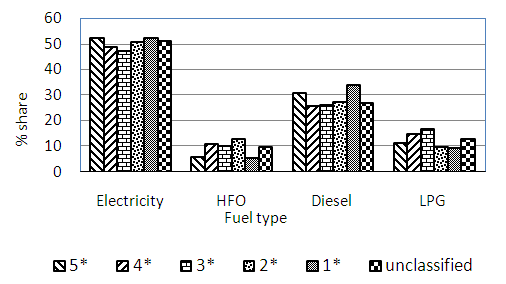 | Figure 1. Energy utilization of graded establishments – 2010 |
Detailed breakdown of the end consumers of a hotel was derived through a closer look at the energy utilization of a five star hotel. This represents the application of electricity and thermal energy of the hotel and depicted in Figure 2. This particular hotel has a robust energy monitoring program through sub-metering. Major energy consuming areas of the hotel include MVAC, lighting and hot water and steam supply whilst MVAC alone accounts for 47%. This hotel uses LPG for cooking, diesel for self-electricity generation, HFO for steam boiler operation to produce steam and hot water and electricity for all remaining services. The hotel is located in a hot, humid climate and thus the demand for cooling is comparatively high. This is the reason for MVAC to be the highest energy consumer among all. The hotel also provides a contract laundry service apart from the facility provided for the in-house guests and this has a direct effect on electrical consumption.  | Figure 2. Total energy consumption by end use of a hotel |
Though this energy representation cannot be generalized for all hotels, the end use categories will remain almost the same except for different climate conditions since air conditioning is not relevant to the hotels in the colder climates and also is not provided in smaller hotels in the coastal belt around the country.Through a comprehensive data analysis and LEAP modeling, energy demand and electricity generation patterns were forecasted. Further, the environmental effects and the financial component in line with different scenarios were obtained. The results of the study are discussed under demand, transformation, environmental effects and economic analysis.
3.2. Demand Forecast
Energy demand is forecasted based on the existing expansion plan of the graded hotel establishments to cater the envisaged target in the year 2016 as shown in Figure 3. The ascending trend of the energy demand in the tourism industry for all type of graded hotels shows the requirement of expanded electricity generation, impact on the environment and increased cost involvement as well.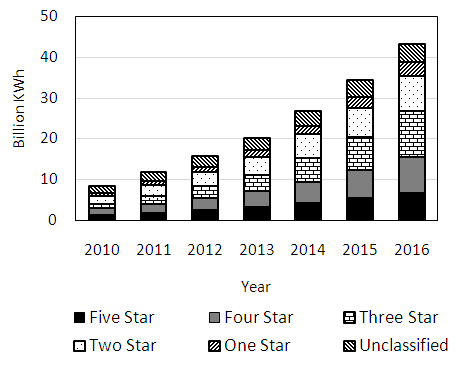 | Figure 3. Energy demand forecast based on envisaged target at 2016 |
Figure 4 shows the advantage of implementing DSM over the existing demand. The energy savings are demonstrated by a negative energy demand against the baseline scenario resulted through DSM measures.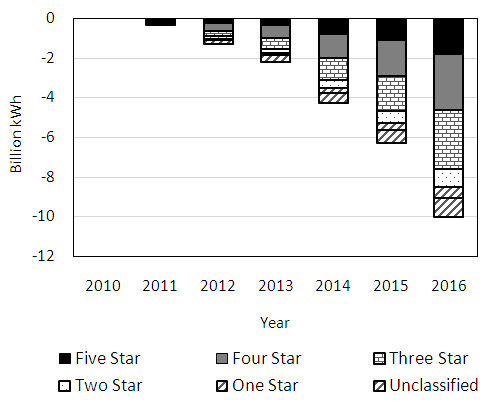 | Figure 4. Advantage of DSM over existing demand |
Implementing DSM measures is also important in the present context of the Sri Lankan tourism industry in several ways. In general hotels consume a substantial amount of electricity with more than 60% of total energy utilization for MVAC and lighting. Therefore, reducing electricity usage for the same level of energy services reduces the energy costs, resulting in increased profits.The saving electricity reduces the generation requirements and in phase with this transmission and distribution losses are minimized, giving an appreciable savings to the country. Electricity at present context is generated mainly through fossil fuels; coal and oil. More is the generation of electricity through these fuels; more would be the environmental impacts. It creates local as well as global pollution through emissions associated with such fuels. By introducing DSM concepts, the electricity demand can be reduced so will it reduce the environmental pollution.Energy prices increase gradually in the international market. Sri Lanka depends on oil and coal imports for electricity generation. Oil price shocks in several occasions have given a lesson to adopt energy conservation and efficient technologies for production and usage of electricity.
3.3. Transformation Forecast
Based on the LTGEP (Long-term Generation Expansion Plan) of CEB, the baseline scenario was modeled in LEAP and the related electricity generation plan for the study period is shown in Figure 5. It implies the non-availability of new NCRE sources in the generation mix while the induction of coal power plants increases steadily. The hydro capacities indicate only the major hydro plants being committed.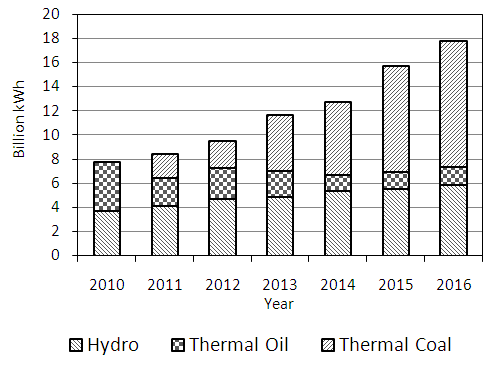 | Figure 5. Electricity Generation profile - Baseline scenario |
In line with the LTGEP of CEB and the National Energy Policy, the generation mix was forecasted through LEAP and the existence of new NCRE was not significant. The electricity generation mix forecasted based on the National Energy Policy is depicted in Figure 6.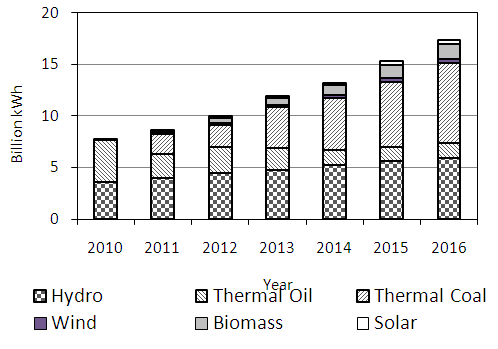 | Figure 6. Electricity Generation based on National Energy Policy |
Whilst carrying out additions of renewable plant, the existing thermal plant retirements and new additions were done in order to sustain the generation requirement with the forecasted demand. Figure 7 and Figure 8 show the comparison of plant additions and retirements of Energy Policy target scenario and Coal free generation scenario against baseline scenario respectively.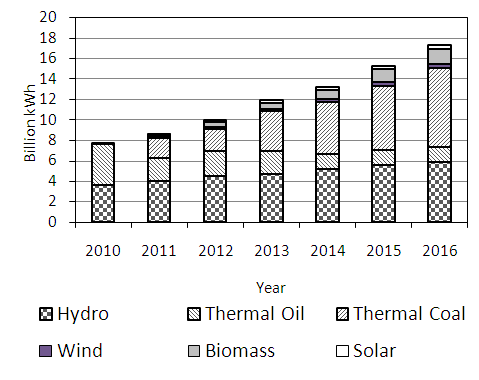 | Figure 7. Comparison of Electricity Generation mixes (EPT vs BAS) |
 | Figure 8. Comparison of Electricity Generation mixes (COA vs BAS) |
Figure 9 shows the comparison of plant additions and retirements of Renewable Promotion scenario against Energy Policy target scenario. This hypothetical case was modeled by retiring the thermal plants and adding NCRE plants, mainly wind and biomass though the practical implementation in Sri Lanka was not seen in the near future. However, a brief discussion on the availability of NCRE sources and on the non-existence of them in the generation mix of Sri Lanka follows. It indicates the reasons for this scenario to be ‘hypothetical’. 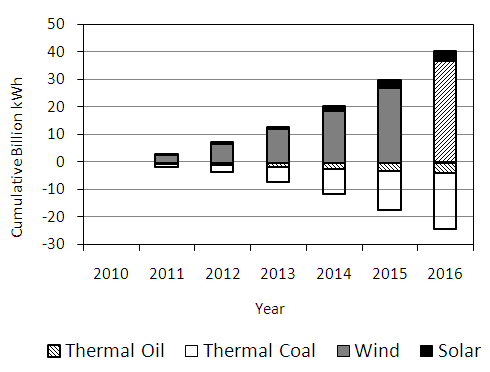 | Figure 9. Comparison of Electricity Generation mixes (REN vs EPT) |
Country has untouched technical potential of NCRE, about 250 MW mini/micro hydro power, 1000 MW biomass thermal power and over 20000 MW wind power [12]. However, these are not been captured by the LTGEP of CEB owing to technical, economical and social barriers. Furthermore, though the studies reveal that the country has a considerable amount of untouched NCRE potential, Sri Lanka is not geared to test them properly; for example, wind measuring masts are not established at the northern and northwestern coastal belts, where a higher wind potential has been reported. The CEB incurs heavy losses in sustaining the thermal power plants due to unexpected price hikes of fuel in the global fuel market. Thus the Government of Sri Lanka carries the burden by providing grants, subsidies and removing taxes and other levies owned by CEB. For the same reason, fuel costs of conventional thermal power generation do not represent the exact values and thus subsidized prices were used for calculations. Competitive advantage of having free fuel in NCRE options are not highlighted due to this. CEB follows a least cost option in the selection process of candidate plants in the generation mix and NCRE options will not be attractive in that sense. In order to maintain the system stability and integrity, CEB has put up certain limits of dispatch capacity for NCRE sources. This is another restriction for harnessing the NCRE sources available in Sri Lanka. The electricity transmission and distribution network in the country requires to be modified to overcome this issue. Investors are reluctant to take up unproven projects. The techno-economical feasibilities are to be done by the Government to promote the stakeholders in investing on NCRE technologies. As per Table 1 of LTGEP of CEB in 2010 and even in 2013, not a single NCRE plant has been considered as candidates. Even though the CEB maintains a 3 MW wind plant as a pilot project at Hambanthota, the Table 1 of LTGEP carries end note ‘Wind is a non-dispatchable source of energy. Therefore, it has not been accounted for the total’ [13]. Thus, the future power generation in Sri Lanka is dominated by coal plants together with oil and hydro as the remaining share. Further the country is lacking the studies on dynamic grid stability and power system flexibility to incorporate the potential of NCRE sources.The selection of a candidate plant for the generation plan is influenced by the national interests prioritizing the reliability of power supply and the foreign currency savings. Furthermore, the access to technical know-how and impacts on cultural, heritage and aesthetics are considered. Currently NCRE become the least attractive option on these national interests.
3.4. Environmental Impacts
Impacts to the environment were scanned mainly through demand and generation perspectives. With the increase of energy utilization in the tourism industry, gradual increase of CO2 emissions and the global warming potential was observed in the baseline scenario as shown in Figure 10. 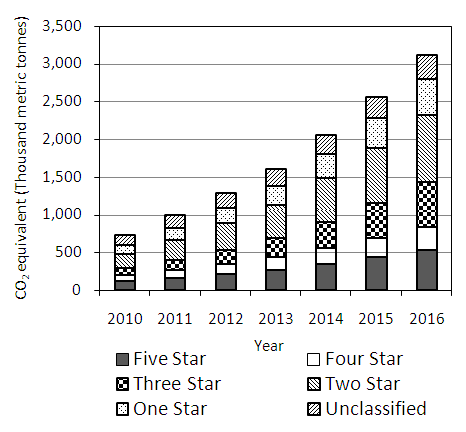 | Figure 10. Increase of global warming potential |
Once the demand is mitigated through DSM measures, a significant reduction of global warming potential was noticed as depicted in Figure 11. | Figure 11. Reduction of one hundred year global warming potential through DSM measures |
Based on the LEAP model, it was observed that the energy policy target does not emit CO2 non biogenic as shown in Figure 12. This plan will still emit CO2 biogenic due to induction of biomass plants for electricity generation throughout the years which would not harm the environment. This is resulted from thermal plant retirements and additions of new NCRE sources in the electricity generation mix. | Figure 12. Avoided CO2 emissions through Alternative energy sources |
If the country could afford a crucial change in electricity generation by adding NCRE to the extent stipulated under renewable promotion scenario, which was treated as a hypothetical case in this study, a further reduction of CO2 was observed as shown in Figure 13. In this, the environmental impacts of renewable promotion scenario were compared against energy policy target scenario. This can be considered as a competitive advantage of renewable promotion over other scenarios. However, the constraints in doing so are descriptively elaborated in the concluding notes. Environmental Impact Assessment (EIA) enforces national and regional standards of pollution control for power plants. However, EIA is only used as a tool of delaying a construction of a power plant in the present context of Sri Lanka and it does not enforce the limitations due to the lower CO2 emission level. Apart from the major GHG emissions, coal ash also contains toxic heavy metals and coal burning plants are a leading source for emission of radioactive materials to the environment [14]. Thus it is important to note that the affordable electricity through coal is delivered at a steeper environmental price. Irrespective of afore mentioned facts, the CEB has chosen coal being the cheapest technology at the expense of the environment. | Figure 13. Competitive advantage of NCRE additions |
3.5. Economic Analysis
Final results of economic analysis display the performance of the studied scenarios based on the constraints and assumptions made in the study. Therefore, the results of this study may not interpret the exact cost figures. However, these results provide a platform to compare various scenarios and technologies. Figure 14 compares the predicted social costs of the studied scenarios as at year 2016. Renewable promotion scenario considers addition of NCRE technologies over thermal additions. Thus capital cost intensiveness of the NCRE plant additions is obviously seen in this figure. Further, the variable operation and maintenance cost for NCRE sources are zero with the exception for biomass which is 0.53 US cent/kWh. Therefore the variable O&M cost in the renewable promotion scenario shows a clear reduction. Lesser externality costs involved in the renewable promotion scenario is also an interesting result observed through this. 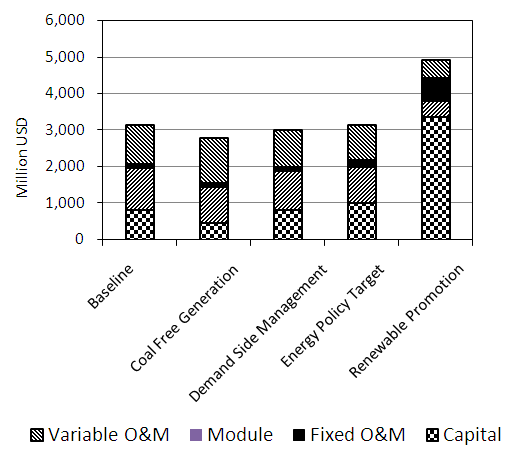 | Figure 14. Cumulative discounted social costs as at year 2016 |
Costs for demand in all scenarios other than the DSM Scenario are zero for all hotel establishments because they carry same level of demand. Energy demand intensity of DSM scenario is less than that of BAS scenario and thus indicated by the negative values.
4. Conclusions
Post war turnaround witnessed by the tourism industry in Sri Lanka continues its growth momentum towards a successful future. Sustainable development of the industry is crucial because it carries a considerable share of GDP of the country. Further the requirement exists to upgrade Sri Lanka from the perception of ‘affordable destination’ whilst showcasing its milestone in year 2016. Analytical studies over the tourism industry of Sri Lanka on energy utilization are rare. In the aim of sustainable development, the future of the industry needs to be forecasted in terms of energy supply and utilization, which is approached by the study. The associated environmental impacts are also weighed because greening the tourism industry paves the way to its consistency. The study also gives an opportunity to the stakeholders including the policy makers to make decisions pertaining to the tourism industry and electricity generation through a socio-economic comparison based on cost-benefit analysis.The results of the study suggest the following conclusions;(a) Evaluation of energy consumption of hotels is challenging than other building types and the energy consumption situation in such environment carries a different identity among other industries. Thus in order to reach at a precise analysis on the energy utilization of the tourism industry, detailed data analysis of the industry around the country is required. Some small and medium scale hotel chains still do not realize the value of data monitoring and create barriers for a complete study. (b) Implementation of DSM measures in the tourism industry is mandatory to mitigate the energy intensiveness along with the impulsive growth expected in a shorter time span in the country. Sri Lankan tourism is in the process of grabbing the DSM measures and benefited by the same.(c) Electricity in the present context is generated mainly through fossil fuels. Induction of NCRE sources into the electricity generation mix in parallel with the National Energy Policy is more environmental friendly than following the existing generation plan of CEB. However this process will not come into reality in the near future due to the restrictions in practical implementation. (d) The existing LTGEP of CEB does not accommodate fuel diversification and energy mix . It is a plan based on the least cost principle. Thus there is no room for NCRE promotion in the current generation plan of the country. This in turn demands the necessity of revisions in current generation planning.(e) According to the study, Sri Lanka, in the aim of marching towards greening the tourism industry should adopt energy generation plan based on a more environmental friendly scenario such as Energy Policy Target Scenario and Renewable Promotion Scenario.
References
| [1] | Tourism Development Strategy 2011-2016, Ministry of Economical Development. |
| [2] | Annual Statistical Report of Sri Lanka Tourism, 2010. |
| [3] | Statistical Digest, Ceylon Electricity Board, 2010. |
| [4] | Priyadarsini, R., Xuchao, W., and Eang, L. S., A study on energy performance of hotel buildings in Singapore, Journal of Energy and Buildings, Vol. 41, 2009, pp 1319-1324. |
| [5] | Ali, Y., Mustafa, M., Al Mashaqbah, S., Mashal, K., & Mohsen, M., Potential of energy savings in the hotel sector in Jordan, Journal of Energy Conversion and Management, Vol. 49, 2008, pp 3391-3397. |
| [6] | Deng, S., Burnett, J., A study of energy performance of hotel building in Hong Kong, Journal of Energy and Buildings, Vol. 31, 2007, p. 7-12. |
| [7] | Karagiorgas, M., Tsoutsos, T., Moiá-Pol, A., A simulation of the energy consumption monitoring in Mediterranean hotels applications in Greece , Journal of Energy & Buildings, Vol. 39, 2007, pp. 416-426. |
| [8] | Wang, J. C., A study on the energy performance of hotel buildings in Taiwan, Journal of Energy and Buildings, Vol. 49, 2012, pp 268-275. |
| [9] | Udawatta, L., Perera, A., Witharana, S., Analysis of Sensory Information for Efficient Operation of Energy Management Systems in Commercial Hotels, EJSE Special Issue: Wireless Sensor Networks and Practical Applications, 2010. |
| [10] | Sri Lanka Energy Balance, An analysis of the energy sector performance, Sri Lanka Sustainable Energy Authority, 2011. |
| [11] | Heaps, C.G., Long-range Energy Alternatives Planning (LEAP) system [Software version 2012.0055] Stockholm Environment Institute. Somerville, MA, USA. www.energycommunity.org. |
| [12] | Conference proceedings, ‘Achieving sustainability and equity in energy: policy choices for the future and practical actions’, Sri Lanka Sustainable Energy Authority, 2008. |
| [13] | Long-term Generation Expansion Plan Ceylon Electricity Board, December, 2010. |
| [14] | Rhodes, Richard & Beller, Denis, The need for nuclear power, Foreign affairs, 79(1), 2000, pp. 30 – 44. |















 Abstract
Abstract Reference
Reference Full-Text PDF
Full-Text PDF Full-text HTML
Full-text HTML